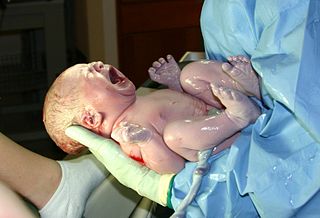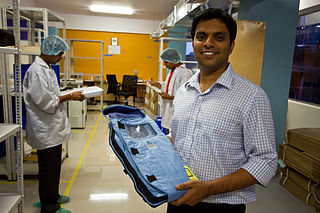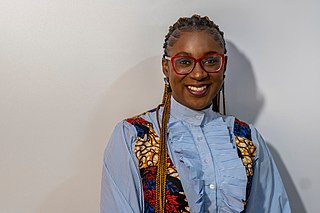
A planetarium is a theatre built primarily for presenting educational and entertaining shows about astronomy and the night sky, or for training in celestial navigation.

Bell and Howell LLC is a U.S.-based services organization and former manufacturer of cameras, lenses, and motion picture machinery, founded in 1907 by two projectionists, and originally headquartered in Wheeling, Illinois. The company is now headquartered in Durham, North Carolina, and currently sells production mail equipment, buy-online-pickup-in-store (BOPIS) smart locker and kiosk solutions, and provides maintenance services for automated, industrial equipment in enterprise-level companies. Since 2010, the Bell + Howell brand name has been extensively licensed for a diverse range of consumer electronics products.

Neonatology is a subspecialty of pediatrics that consists of the medical care of newborn infants, especially the ill or premature newborn. It is a hospital-based specialty and is usually practised in neonatal intensive care units (NICUs). The principal patients of neonatologists are newborn infants who are ill or require special medical care due to prematurity, low birth weight, intrauterine growth restriction, congenital malformations, sepsis, pulmonary hypoplasia, or birth asphyxia.

A neonatal intensive care unit (NICU), also known as an intensive care nursery (ICN), is an intensive care unit (ICU) specializing in the care of ill or premature newborn infants. The NICU is divided into several areas, including a critical care area for babies who require close monitoring and intervention, an intermediate care area for infants who are stable but still require specialized care, and a step down unit where babies who are ready to leave the hospital can receive additional care before being discharged.

A bili light is a light therapy tool to treat newborn jaundice (hyperbilirubinemia). High levels of bilirubin can cause brain damage (kernicterus), leading to cerebral palsy, auditory neuropathy, gaze abnormalities and dental enamel hypoplasia. The therapy uses a blue light (420–470 nm) that converts bilirubin into an (E,Z)-isomer that can be excreted in the urine and feces. Soft goggles are put on the child to reduce eye damage from the high intensity light. The baby is kept naked or only wearing a diaper, and is turned over frequently to expose more of the skin.

Neonatal jaundice is a yellowish discoloration of the white part of the eyes and skin in a newborn baby due to high bilirubin levels. Other symptoms may include excess sleepiness or poor feeding. Complications may include seizures, cerebral palsy, or kernicterus.
Amy Smith is an American inventor, educator, and founder of the MIT D-Lab and senior lecturer of mechanical engineering at MIT.
Mimio is a brand name of a line of technology products aimed at the education market. The primary products were originally focused around computer whiteboard interactive teaching devices. MimioCapture devices also allow users to capture all of the ink strokes that are written on the whiteboard. When used in conjunction with a video projector it turns the ordinary whiteboard surface into a fully interactive whiteboard. The product line has been dramatically expanded in the last two years as described in the "Hardware Products" and "Software Products" sections below.

A planetarium projector, also known as a star projector, is a device used to project images of celestial objects onto the dome in a planetarium.

Neonatal nursing is a sub-specialty of nursing care for newborn infants up to 28 days after birth. The term neonatal comes from neo, "new", and natal, "pertaining to birth or origin". Neonatal nursing requires a high degree of skill, dedication and emotional strength as they care for newborn infants with a range of problems. These problems vary between prematurity, birth defects, infection, cardiac malformations and surgical issues. Neonatal nurses are a vital part of the neonatal care team and are required to know basic newborn resuscitation, be able to control the newborn's temperature and know how to initiate cardiopulmonary and pulse oximetry monitoring. Most neonatal nurses care for infants from the time of birth until they are discharged from the hospital.

Gustave Pierre Trouvé was a French electrical engineer and inventor in the 19th century. A polymath, he was highly respected for his innovative skill in miniaturization.
The Lemelson Foundation is an American 501(c)(3) private foundation. It was started in 1993 by Jerome H. Lemelson and his wife Dorothy. The foundation held total net assets of US$444,124,049 at the end of 2020 and US$484,432,021 at the end of 2021.

Sir Raymond John Avery is a New Zealand pharmaceutical scientist, inventor, author and social entrepreneur.

Jane Marie Chen is the co-founder of Embrace, a social enterprise startup that produces a low-cost infant warmer, that gives premature and low-birth-weight infants a better chance at survival.

Rahul Alex Panicker is a technology leader and entrepreneur, formerly Chief Innovation Officer at the Wadhwani Institute for Artificial Intelligence, and best known as the President and Co-founder of Embrace Innovations and Embrace, a social enterprise startup that aims to help premature and low-birth-weight babies, through a low-cost infant warmer.
Embrace Innovations is an Indian healthcare technology company specializing in infant warmers. The company produces neonatal warming bags which are used to help reduce the risk of hypothermia in pre-term infants.

Equalize Health is a not-for-profit medical technology company with offices in India, Kenya, and the United States.
Patents for Humanity is an awards program run by the United States Patent and Trademark Office.

Crib A'Glow is a portable solar-powered phototherapy unit that uses blue LED lights to treat infants with jaundice. The device was invented by Virtue Oboro, a visual designer and mother whose newborn son had developed jaundice. Crib A'Glow has won multiple prizes for innovation.

Virtue Oboro is a Nigerian entrepreneur, and Co-founder of Tiny Hearts Technology. In 2016, she developed and launched Crib ‘A Glow, an LED-lit portable crib that treats jaundice utilizing solar energy, and patented the innovation in 2017.














